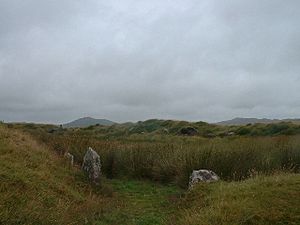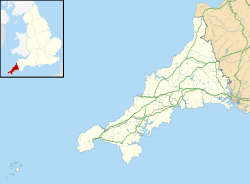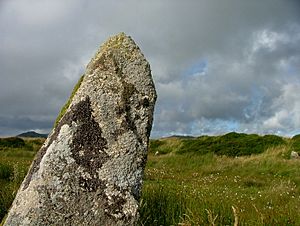King Arthur's Hall facts for kids
 |
|
| Location | Bodmin Moor, Cornwall |
|---|---|
| Coordinates | 50°34′06″N 4°38′33″W / 50.56833°N 4.64250°W |
| Type | Megalithic enclosure |
| History | |
| Periods | Neolithic / Bronze Age |
King Arthur's Hall is an ancient stone structure located on Bodmin Moor in Cornwall, England. It is a type of megalithic enclosure, meaning it's an area surrounded by large stones. People believe it was a special place for ceremonies during the late Neolithic period (Stone Age) or early Bronze Age.
What is King Arthur's Hall?
This ancient monument has 56 large stones. They are set up in a rectangle, surrounded by an earth bank. The whole area is about 20 meters (65 feet) wide and 47 meters (154 feet) long.
The inside of the hall often fills with water, like a shallow pool. We don't know exactly how deep the ground was when it was first built. Cows used to damage the site, but now a fence protects it. You can visit King Arthur's Hall by following footpaths east of St Breward.
Around King Arthur's Hall, you can find other ancient sites. These include stone circles, hut circles (where ancient homes once stood), cairns (stone mounds), and cists (stone burial boxes).
Why Was it Built?
Since no ancient tools or items have been found here, we can only guess why King Arthur's Hall was built.
A similar stone enclosure in Brittany, France, was used for cremations during the Bronze Age. However, another similar structure in Lough Gur, Ireland, suggests an earlier date from the Neolithic period. Some people even thought it was just a medieval cattle pen. But the huge effort needed to build the earth bank and set up the large stones suggests it had a much more important purpose.
Recent Discoveries
In 2013 and 2014, members of The Heritage Trust did some clearing and research at King Arthur's Hall. Their work showed a special wall built to hold up the inner earth bank.
They found that over time, earth had covered the top of this wall. They believe that about 140 upright stones are now buried, lying down, or leaning at an angle. Researchers think the structure might have originally formed a tank that filled with water. This water could have been used for important rituals or ceremonies long ago.




